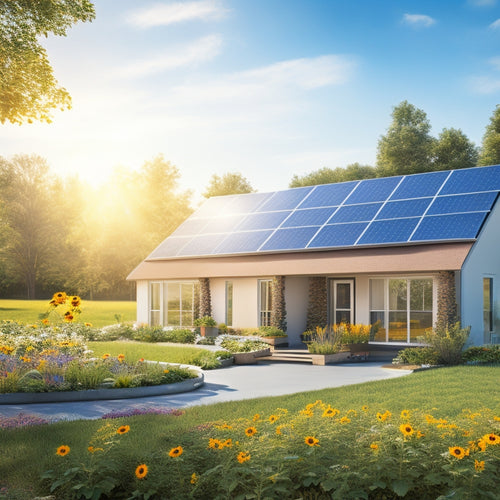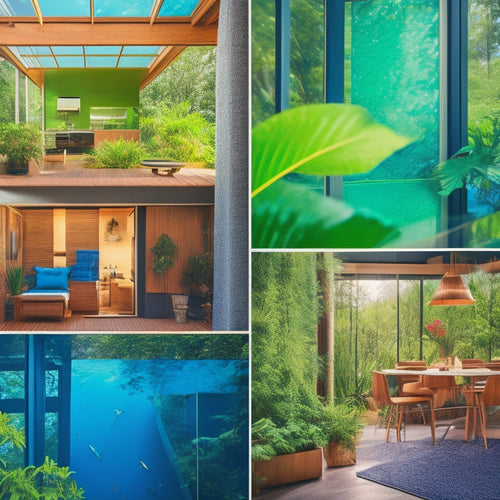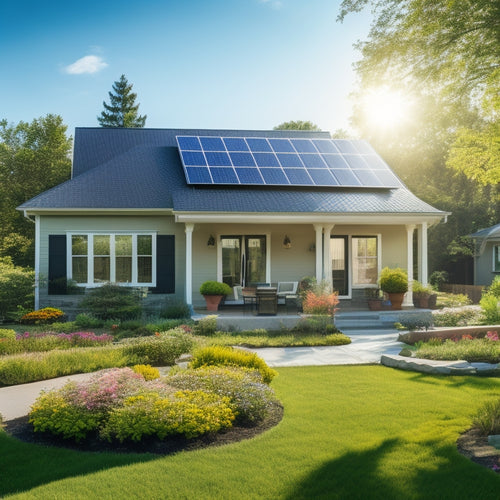The Art of Sustainability: Eco-Friendly Materials in Home Decor
Share
As you design your dream home, you're not only creating a space that reflects your style, but also making a conscious decision to reduce your environmental footprint. You can start by incorporating eco-friendly materials into your home decor. Bamboo, a highly renewable resource, adds a unique touch to any room. Reclaimed wood brings a blend of history and character, while eco-friendly textiles like natural fiber fabrics and recycled materials promote a healthier living space. Explore the world of sustainable materials, and discover how you can create a stunning, eco-friendly haven that's as unique as you are, and there's so much more to explore beyond this.
Key Takeaways
• Incorporating eco-friendly materials in home decor reduces carbon footprint, creates a healthier living space, and saves energy and money.
• Sustainable materials like bamboo, reclaimed wood, and natural fibers offer durability, aesthetic appeal, and environmental benefits.
• Eco-friendly textiles, such as organic cotton and recycled materials, promote a healthier living space and reduce waste.
• Glass and upcycled decor add elegance and sophistication while reducing environmental footprint and supporting a circular economy.
• Low-VOC paints and energy-efficient lighting options improve indoor air quality, reduce energy consumption, and promote a sustainable lifestyle.
Sustainable Materials for a Greener Home
By incorporating eco-friendly materials into your home decor, you're not only reducing your carbon footprint but also creating a healthier, more sustainable living space that benefits both you and the environment.
One of the most effective ways to achieve this is by using sustainable materials in your home's construction. For instance, opting for Earth-friendly insulation can substantially reduce energy consumption and minimize waste. This not only helps the environment but also saves you money on energy bills.
Incorporating green architecture principles into your home design can also make a substantial impact. By using recycled materials, reducing waste, and optimizing natural light, you can create a home that's not only eco-friendly but also aesthetically pleasing.
Additionally, using low-VOC (volatile organic compound) paints and sustainable flooring options can improve indoor air quality, making your home a healthier space for you and your loved ones.
Bamboo: The Ultimate Eco-Friendly Material
You'll be hard-pressed to find a more eco-friendly material than bamboo, which offers an unparalleled combination of sustainability, durability, and aesthetic appeal.
This highly renewable resource is harvested from bamboo forests, which are capable of sequestering more carbon dioxide and producing more oxygen than many other types of forests. Bamboo architecture is becoming increasingly popular, and for good reason.
Rapid regeneration: Bamboo can grow up to 3 feet per day, making it a highly renewable resource.
Carbon sequestration: Bamboo forests are incredibly effective at absorbing carbon dioxide from the atmosphere.
Durability: Bamboo is incredibly strong and durable, making it perfect for a wide range of applications.
Aesthetic appeal: Bamboo adds a unique, natural touch to any room, making it a popular choice for home decor.
Reclaimed Wood for a Unique Look
Take a step back in time with reclaimed wood, which brings a unique blend of history and character to your home decor, making it an eco-friendly material that's as sustainable as it's stylish.
You'll love the rustic charm that reclaimed wood accents bring to your space, adding warmth and depth to any room. From wooden beams to reclaimed flooring, this eco-friendly material is perfect for adding a touch of nostalgia to your home.
Plus, by repurposing old wood, you're reducing waste and giving new life to materials that would otherwise end up in landfills. When incorporating reclaimed wood into your home decor, consider pairing it with modern elements to create a striking contrast.
For example, pair a reclaimed wood coffee table with sleek, minimalist chairs for a look that's both rustic and refined. With reclaimed wood, the possibilities are endless, and the benefits to the environment are undeniable.
Low-VOC Paints for a Healthier Space
When it comes to creating a healthier living space, choosing the right paint is essential, and that's where low-VOC paints come in, offering a safer, eco-friendlier alternative to traditional paints. You're not only doing the planet a favor, but you're also creating a healthier environment for you and your loved ones.
Low-VOC paints reduce the amount of volatile organic compounds (VOCs) released into the air, which can aggravate respiratory issues and other health problems.
Improved Indoor Air Quality: Low-VOC paints minimize the release of harmful chemicals, creating a healthier breathing environment.
Color Psychology: With a wide range of colors to choose from, you can select a hue that boosts your mood and energy levels.
Advanced Paint Technology: Low-VOC paints have come a long way, offering superior durability and washability without sacrificing performance.
Eco-Friendly: By choosing low-VOC paints, you're reducing your carbon footprint and promoting a more sustainable lifestyle.
Eco-Friendly Fabrics for Upholstery
As you start selecting fabrics for your upholstery, you'll want to ponder the eco-friendly options that not only benefit the environment but also enhance your home's aesthetic.
You'll discover that choosing natural fibers, recycling materials, and opting for organic cotton can make a significant difference in reducing your carbon footprint.
Natural Fiber Options
You can elevate your home's eco-credentials by opting for natural fiber fabrics, a stylish and sustainable choice for upholstery that not only benefits the environment but also adds warmth and texture to your space. Natural fibers are biodegradable, non-toxic, and require minimal processing, making them an attractive option for the eco-conscious homeowner.
When it comes to natural fiber options, you have a range of choices:
Abaca Weaving: Made from the leaf stalks of the abaca plant, this fiber is durable, resistant to saltwater, and has natural UV protection.
Jute Textiles: Jute is a highly renewable resource, requiring minimal water and pesticides to cultivate. It's also biodegradable and compostable.
Hemp Fabric: Hemp is a highly durable and versatile crop that requires minimal water and pesticides. It's also UV-resistant and has natural insulation properties.
Sisal Fabric: Sisal is a sustainable crop that's fast-growing and requires minimal water and pesticides. It's also durable and resistant to wear and tear.
Recycled Material Uses
Often, homeowners looking to reduce their environmental footprint can find innovative solutions in recycled materials, which can be repurposed into durable, eco-friendly fabrics for upholstery.
You can give old materials a new life by choosing recycled textiles for your furniture. Material salvaging is a vital step in reducing waste and conserving natural resources.
When you opt for recycled materials, you're reducing the demand for virgin resources and decreasing the amount of waste sent to landfills.
Incorporating recycled materials into your home decor is easier than you think.
You can find a variety of eco-friendly fabrics made from recycled plastics, old clothing, and even repurposed fabric scraps.
These sustainable fabrics aren't only environmentally friendly but also durable and stylish.
By choosing recycled materials, you're supporting a more circular economy and reducing your carbon footprint.
As you set out on your sustainable home decor journey, remember that every small change counts, and opting for recycled materials is a significant step towards a more eco-friendly future.
Organic Cotton Benefits
When it comes to choosing eco-friendly fabrics for upholstery, consider switching to organic cotton, a natural, chemical-free alternative that not only benefits the environment but also promotes a healthier living space. You'll be wrapping yourself in soft fabrics that are gentle on your skin and the planet.
Opting for organic cotton offers several benefits:
Soil conservation: Organic cotton farming practices help to reduce soil erosion and promote soil health, ensuring a more sustainable future.
Less water waste: Organic cotton requires substantially less water than traditional cotton, reducing the strain on our precious water resources.
Fewer toxic chemicals: Organic cotton farming eliminates the use of toxic pesticides and synthetic fertilizers, creating a healthier environment for farmers and ecosystems.
Breathable and durable: Organic cotton upholstery isn't only soft and comfortable but also incredibly durable, making it a great investment for your home.
Recycled Glass for a Touch of Elegance
As you explore eco-friendly materials for your home, you're likely considering ways to add a touch of sophistication to your space.
Recycled glass is an excellent option, offering a luxurious feel while also reducing waste.
Glass in Modern Design
By incorporating recycled glass into your modern design, you can add an air of elegance and sophistication to your space while also reducing your environmental footprint. This sustainable material isn't only eco-friendly but also offers a unique aesthetic appeal.
Glass accents, such as recycled glass vases or decorative bowls, can add a touch of sophistication to any room.
Textured panels: Use recycled glass to create textured panels that add depth and visual interest to your walls.
Glass mosaics: Create stunning glass mosaics that can be used as accent walls, tabletops, or even flooring.
Glass countertops: Opt for recycled glass countertops that are durable, easy to clean, and eco-friendly.
Glass lighting fixtures: Add a touch of elegance with recycled glass lighting fixtures that are both sustainable and stylish.
Eco-Friendly Decor Options
You can easily elevate your space with eco-friendly decor options that incorporate recycled glass for a touch of elegance.
This versatile material can be used in a variety of ways to create a sophisticated and sustainable atmosphere. Consider adding a stunning glass chandelier or pendant light to your dining room or living area.
Not only will it add a touch of glamour, but it'll also reduce waste and conserve natural resources.
For a more subtle approach, incorporate recycled glass into your decor through vases, candle holders, or coasters.
These small accents can make a big impact when it comes to adding a touch of eco chic to your space.
You can also take it a step further by incorporating green walls into your design.
These living walls not only purify the air but also create a calming ambiance.
By incorporating recycled glass and green walls into your design, you'll be creating a space that's not only beautiful but also sustainable.
With a little creativity, you can create a stunning and eco-friendly space that's perfect for relaxing and entertaining.
Natural Fiber Rugs for a Cozy Feel
Natural fiber rugs, woven from materials like sisal, jute, or seagrass, bring warmth and texture to a room, instantly making it feel cozier and more inviting. As you consider incorporating eco-friendly materials into your home decor, natural fiber rugs are an excellent choice. Not only do they add a touch of organic charm to your space, but they're also biodegradable and compostable.
Durable and low-maintenance: Natural fiber rugs are resistant to wear and tear, and they're easy to clean and maintain.
Sustainable and eco-friendly: Made from natural, renewable resources, these rugs are a great choice for those looking to reduce their environmental impact.
Aesthetic versatility: Natural fiber rugs come in a range of textures, colors, and patterns, making them easy to incorporate into any design style.
Health benefits: Natural fiber rugs are a great choice for those with allergies or sensitivities, as they're free from harsh chemicals and synthetic materials.
Energy-Efficient Lighting Options
As you aim to create a more eco-friendly home, switching to energy-efficient lighting options can make a significant impact on reducing your carbon footprint.
By incorporating smart fixtures and green lamps into your home decor, you'll not only be doing the planet a favor, but you'll also save on energy costs in the long run.
LED bulbs, for instance, use up to 90% less energy than traditional incandescent bulbs, making them an excellent choice for eco-conscious homeowners.
Additionally, many energy-efficient lighting options are designed to last longer, reducing waste and the need for frequent replacements.
Look for lamps and fixtures that are certified by organizations such as Energy Star, which verifies that they meet strict energy efficiency guidelines.
Upcycled Decor for a Personal Touch
One of the most creative ways to add a personal touch to your eco-friendly home decor is by incorporating upcycled decor pieces that not only reduce waste but also tell a unique story. Upcycled decor is an excellent way to express your personal style while reducing your environmental footprint. You can create a one-of-a-kind space that reflects your personality and values.
Vintage Revival: Breathe new life into old items like vintage windows, doors, or furniture by repurposing them as decorative pieces or functional items.
Macrame Magic: Transform old t-shirts, ropes, or fabric scraps into stunning macrame wall hangings or plant holders.
Glass Act: Upcycle old glass bottles or jars into unique vases, candle holders, or storage containers.
Fabric Frenzy: Turn old fabric scraps into colorful throw pillows, quilts, or even a statement piece of wall art.
Frequently Asked Questions
Can I Mix and Match Sustainable Materials for a Unique Look?
You can absolutely mix and match sustainable materials for a unique look, achieving Design Harmony through a thoughtful Material Mashup that balances textures, colors, and styles to create a space that's both eco-friendly and visually stunning.
Are Eco-Friendly Materials More Expensive Than Traditional Options?
You're wondering if eco-friendly materials break the bank. While they often come with a price premium, market trends show consumers are willing to pay more for sustainable options, driving industry standards and economic impact, all while optimizing the supply chain.
How Do I Properly Clean and Maintain Sustainable Materials?
When incorporating sustainable materials, you'll want to develop a daily routine for cleaning and maintenance. Understanding material science helps you tailor your approach, ensuring you're preserving the integrity of eco-friendly materials and extending their lifespan.
Are There Any Certifications for Ensuring a Material Is Eco-Friendly?
You're wise to look for credible certifications! Opt for products with recognized green badges like FSC, Oeko-Tex, or Greenguard, which guarantee eco-friendliness through rigorous environmental labels, giving you peace of mind about your sustainable choices.
Can I DIY Sustainable Decor Projects or Should I Hire a Professional?
As a DIY enthusiast, you can definitely tackle sustainable decor projects on your own, but for more complex or large-scale projects, consider seeking professional guidance to guarantee a flawless, eco-friendly result.
Related Posts
-

Home Solar Systems for Environmental Impact
Home solar systems markedly reduce your carbon footprint by utilizing renewable energy. By adopting solar energy, you...
-

Innovative Sustainable Materials for Energy-Efficient Homes
Innovative sustainable materials enable you to create energy-efficient homes while promoting environmental responsibi...
-

Affordable Solar Panels for Home Use
Affordable solar panels offer you a smart way to cut down on energy costs while promoting sustainability. With govern...


